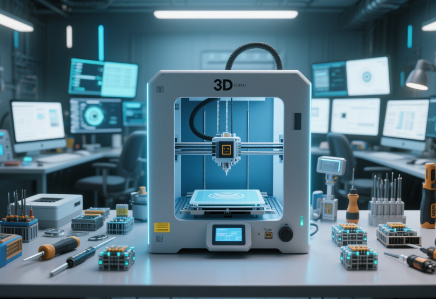The 3D Printing Wave: Revolutionizing the Traditional Design of Miniature Connectivity Modules
In the fast - paced tech world, the need for smaller, more efficient, and integrated components is soaring. Miniature connectivity modules, crucial for seamless device communication, are at the heart of this revolution. 3D printing is a game - changer for these modules, challenging traditional design and unlocking new potential for complex, customized, high - performance solutions.
Understanding Miniature Connectivity Modules
Miniature connectivity modules are vital in diverse electronics, from smartphones to aerospace systems. They handle data, power, and signal transmission, often in tight spaces, demanding high performance and reliability.
Key Functions and Requirements
These modules must ensure efficient, stable communication, supporting high - speed data transfer. They also need to endure various environments, like temperature swings and mechanical stress. Design - wise, they require precise integration of components, but traditional manufacturing is complex, time - consuming, costly, and design - restrictive. This is where 3D printing steps in.
How 3D Printing is Transforming Design

Unprecedented Design Freedom
3D printing (additive manufacturing) builds objects layer - by - layer from digital models. It allows for intricate geometries impossible with traditional methods. For miniature connectivity modules, this means customized shapes for better space use and performance. For example, uniquely - shaped antennas with internal lattice structures can be printed, tailored to specific frequencies, reducing module size and interference.
Rapid Prototyping and Iteration
3D printing enables quick prototyping. In the past, module prototyping was slow and costly. Now, functional prototypes can be made in hours or days, allowing for more design iterations. A research team working on IoT sensor modules can quickly print prototypes, test them, spot flaws, and make adjustments, shortening development time.
Material Innovation and Multimaterial Printing
3D printing offers a wide range of materials. For miniature connectivity modules, materials can be chosen based on properties like conductivity and strength. Multimaterial 3D printing allows for integrated electrical, mechanical, and thermal functions. For instance, a module could have silver/copper conductive tracks and a polymer structure, enhancing performance and reducing assembly.
Real - World Applications of 3D - Printed Miniature Connectivity Modules
Wearable Electronics
In wearable electronics, where size and comfort matter, 3D - printed modules are a boon. Companies use 3D - printed flexible circuits and antennas for better fit and signal reception. 3D - printed enclosures can also manage heat during long - term use.
Internet of Things (IoT)
The IoT, with its many small, battery - powered devices, benefits from 3D - printed modules. In smart cities, 3D - printed sensors with integrated connectivity can be deployed in various spots. Printing on - demand reduces manufacturing and inventory costs, making IoT deployments more scalable.
Aerospace and Defense
In aerospace and defense, 3D - printed modules are increasingly used. In aircraft and satellites, customized connectors and wiring harnesses reduce weight and boost reliability. 3D - printed antennas can operate in specific frequencies, and on - site part production speeds up maintenance.
Challenges and Future Outlook
Technical Challenges
3D printing for these modules faces precision and material challenges. Achieving high - tolerance electrical and mechanical connections is tough, and the range of suitable materials is limited. More research is needed for material stability.
Cost and Scalability
Currently, 3D printing is expensive for high - volume production, with printer, material, and post - processing costs adding up. The slow printing speed also restricts mass production. However, as technology advances, costs are expected to drop, and speed and efficiency will improve.
Future Outlook
The future of 3D - printed miniature connectivity modules is promising. As 3D printing matures, more innovations are on the horizon. Integration with AI and nanotechnology could lead to self - optimizing modules. AI could optimize designs in real - time, and nanotechnology could enhance component properties. In short, 3D printing is revolutionizing miniature connectivity module design, and despite challenges, its potential is vast.




